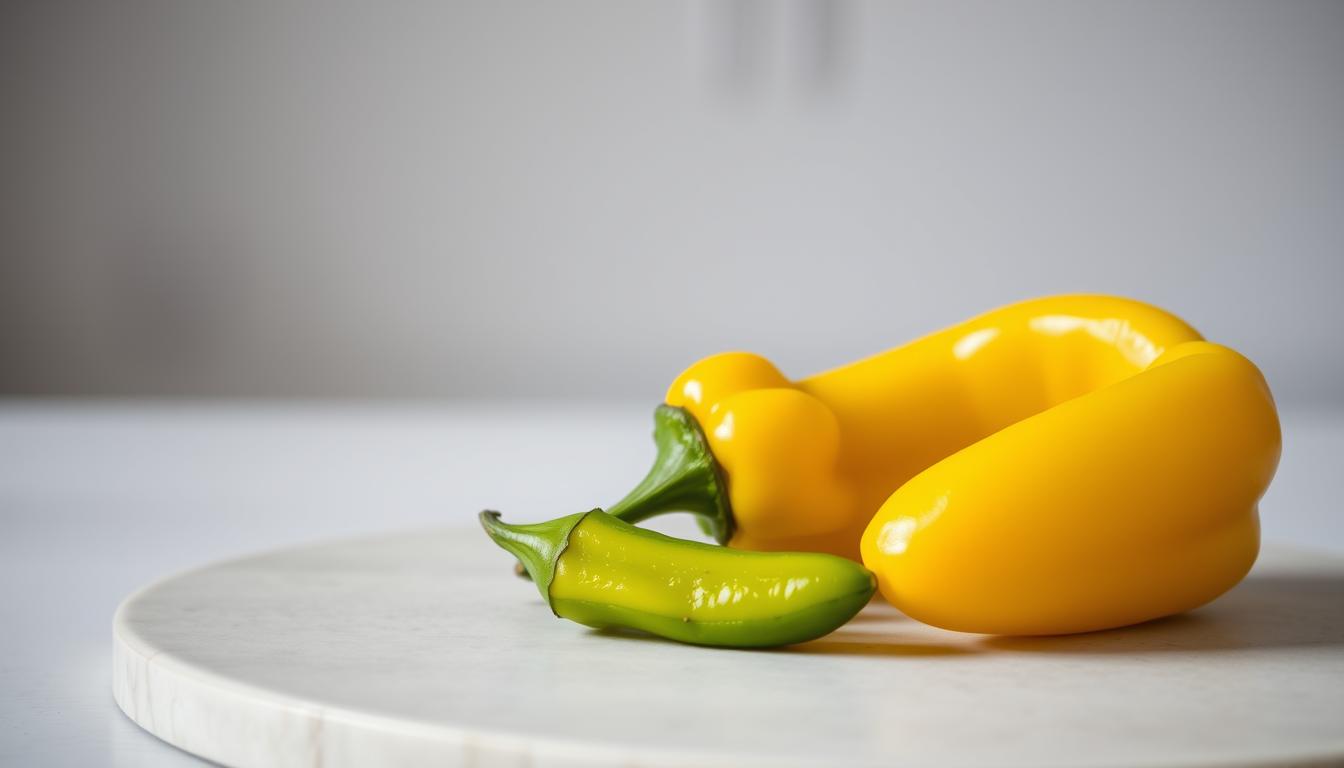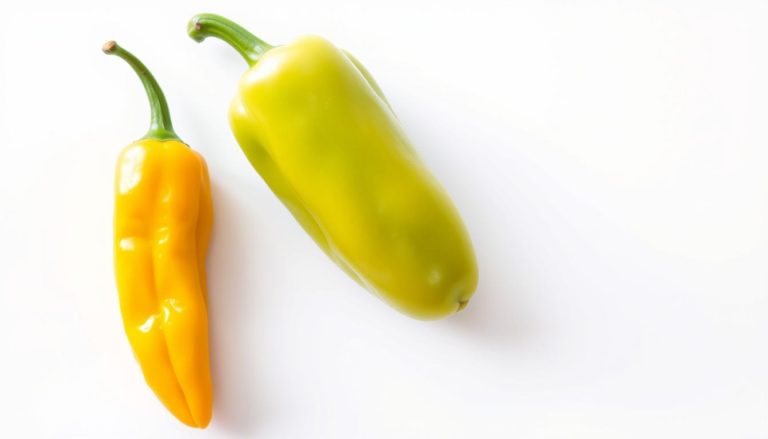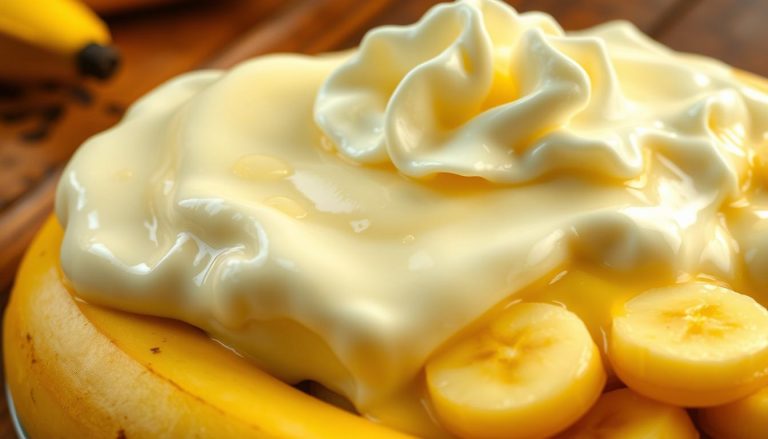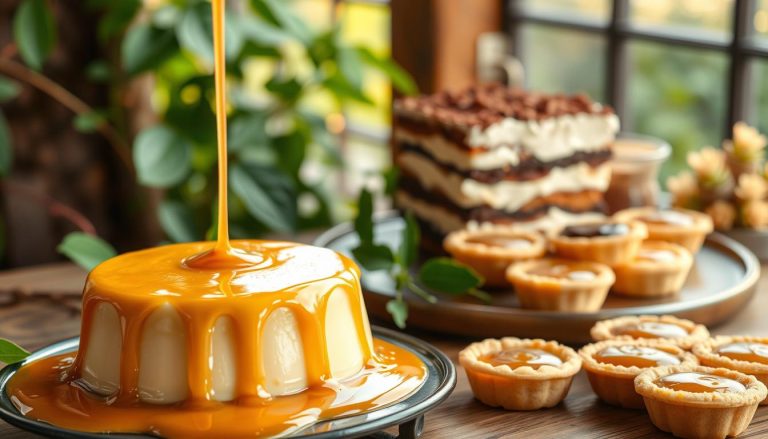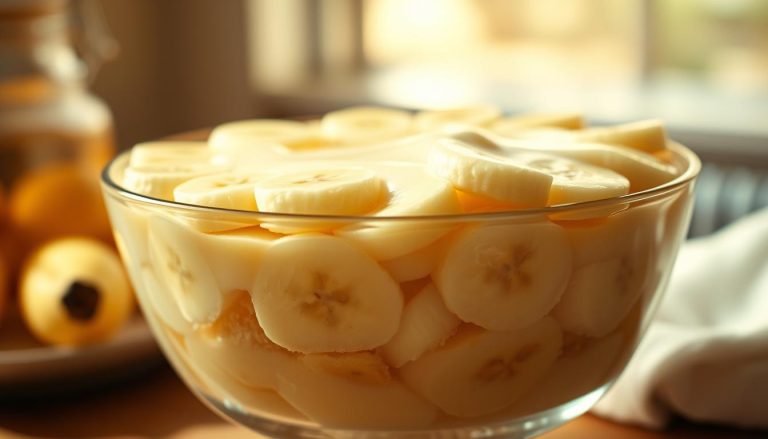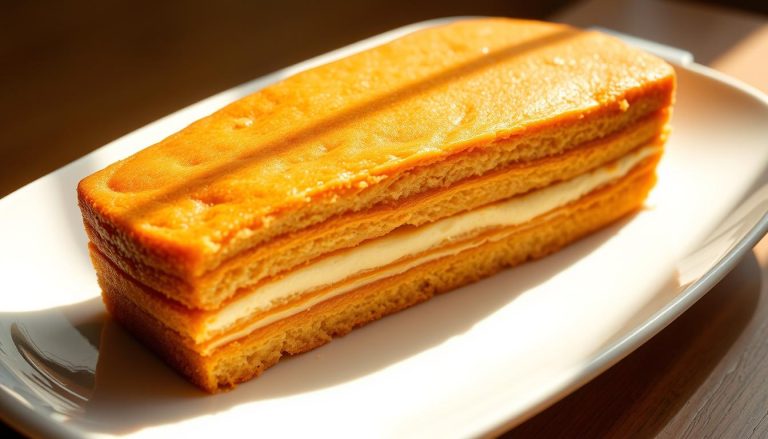Banana Peppers vs Pepperoncini: Which One Should You Use?
Every kitchen has its secrets, and for many, the banana peppers vs pepperoncini mystery is intriguing. Growing up, I saw how these peppers could turn a simple sandwich into a gourmet delight.
Knowing the difference between banana peppers and pepperoncini can make your cooking stand out. These mild, tangy peppers may look alike, but they add special touches to your dishes. They can change the taste and texture of your food.
Whether you’re a pro chef or just starting, exploring these peppers can open up new flavors in your cooking. This guide will show you how to tell them apart, where they come from, and how to use them in your recipes.
Table of Contents
Understanding the Origins and History of Both Peppers
Peppers have a rich history that spans continents and cultures. Exploring pepperoncini and banana peppers reveals two unique varieties. Each has its own origins that have shaped culinary traditions worldwide.
The story of these peppers takes us through different landscapes and traditions. Both pepperoncini vs banana peppers have unique backgrounds. These backgrounds shape their distinct characteristics and uses in cooking.
Mediterranean Roots of Pepperoncini
Pepperoncini come from the Mediterranean, especially Italy and Greece. These mild, tangy peppers have been a key part of southern European cuisine for centuries. Farmers in these areas grew pepperoncini as a versatile ingredient, used fresh or pickled.
- Native to Southern Italy
- Traditionally grown in Greek and Italian gardens
- Integral to Mediterranean cooking
Development of Banana Peppers in the Americas
Banana peppers were developed in the Americas through selective breeding. Unlike pepperoncini, they were grown in North American farmlands. They became popular for their sweet and mild flavor.
- Developed in United States agricultural regions
- Bred for consistent flavor and mild heat
- Quickly adopted in various cuisines
Cultural Significance in Different Cuisines
Both peppers have become global ingredients. Pepperoncini are loved in Italian antipasto, while banana peppers are common in American sandwiches and salads.
Their versatility shows they are more than flavor. They symbolize cultural exchange and culinary innovation.
Physical Characteristics and Appearance Differences
When you look at banana peppers vs pepperoncini, you’ll notice they’re different. Each pepper has its own look that makes it stand out. They might seem alike at first, but they have special features that make them unique.
Banana peppers are bright yellow to yellow-green. They have a long, curved shape like a banana. Their smooth skin and mild look make them easy to spot. Banana peppers are usually 4-6 inches long, making them slender and long.
Pepperoncini peppers look a bit different. They have:
- A wrinkled, more textured exterior
- Colors ranging from light green to bright red when fully ripe
- A shorter, squatter shape compared to banana peppers
- Typically 2-3 inches in length
The ripeness of both banana peppers vs pepperoncini changes how they look. As they ripen, their colors change from green to yellow, orange, or red. This shows they’re getting more flavorful and possibly spicier.
Pro tip: When you’re shopping, choose peppers with smooth, unblemished skin and bright, consistent color. This means they’re fresh and will taste great.
Flavor Profiles: Banana Peppers vs Pepperoncini
Exploring banana peppers opens up a world of flavors. These peppers add unique tastes to your cooking, making any dish better.
Trying these peppers is a treat for your taste buds. Knowing their special qualities can change how you cook and enjoy food.
Heat Level and Scoville Scale Ratings
Banana peppers are surprisingly mild, with a Scoville Heat Unit (SHU) rating of 0-500. They’re great for those who don’t like spicy food. Pepperoncini have a similar mild heat, ranging from 100-500 SHU.
- Banana Peppers: 0-500 SHU
- Pepperoncini: 100-500 SHU
Taste Notes and Subtle Differences
Banana peppers taste slightly sweet and tangy. Pepperoncini have a vinegary and slightly bitter flavor. These small differences can greatly change your dish’s taste.
Texture Comparisons
The texture of these peppers is important in cooking. Banana peppers are crisp and firm, ideal for fresh dishes. Pepperoncini, often pickled, are softer and better in sandwiches and salads.
- Banana Peppers: Crisp and firm
- Pepperoncini: Soft and tender
Nutritional Value and Health Benefits
Both banana peppers and pepperoncini are nutritional powerhouses. They add flavor to your meals and boost your health. These vibrant peppers are packed with nutrients.
Pepperoncini, a favorite in Mediterranean cuisine, has many health benefits. It’s low in calories but high in vitamins. A single serving gives you:
- Vitamin C: Supports immune system
- Vitamin A: Promotes eye health
- Antioxidants: Fights cellular damage
Banana peppers also offer great nutritional value. They are full of essential nutrients that help your body function well. Here are their key nutrients:
| Nutrient | Banana Peppers | Pepperoncini |
|---|---|---|
| Calories | 15-20 per 100g | 10-15 per 100g |
| Vitamin C | High | Very High |
| Fiber | Good | Moderate |
Both peppers are great for a healthy diet. They are low in calories, helping with weight management. Capsaicin in them may also increase metabolism and fight inflammation.
Choosing banana peppers or pepperoncini adds a nutritious and tasty element to your meals. They support your overall well-being.
Common Culinary Applications and Uses
Pepperoncini vs banana peppers add special flavors to American kitchens. They can turn simple dishes into amazing meals. Whether you cook at home or professionally, knowing how to use these peppers will improve your skills.
Exploring banana peppers and pepperoncini shows their amazing versatility. Each pepper has its own special traits, making them great for different recipes.
Popular Dishes and Recipes
Here are some fun ways to use these peppers in your cooking:
- Greek salads with pepperoncini
- Sliced banana peppers in sandwiches and subs
- Pepperoncini on pizza for extra flavor
- Antipasto platters
- Homemade nachos and tacos
Best Cooking Methods
Here are the best ways to cook your peppers:
- Roasting: Highlights their natural sweetness
- Grilling: Adds a smoky taste
- Pickling: Keeps flavors strong
- Raw chopping: Great for fresh salads
Preservation Techniques
Keep your peppers fresh with these methods:
- Refrigeration for short-term storage
- Vinegar-based pickling
- Freezing for long-term storage
- Dehydrating for spice blends
Trying out pepperoncini and banana peppers opens up a world of creativity. Each pepper adds its own special touch to your dishes. This lets you explore many flavors and cooking methods.
Growing and Harvesting Tips for Both Varieties
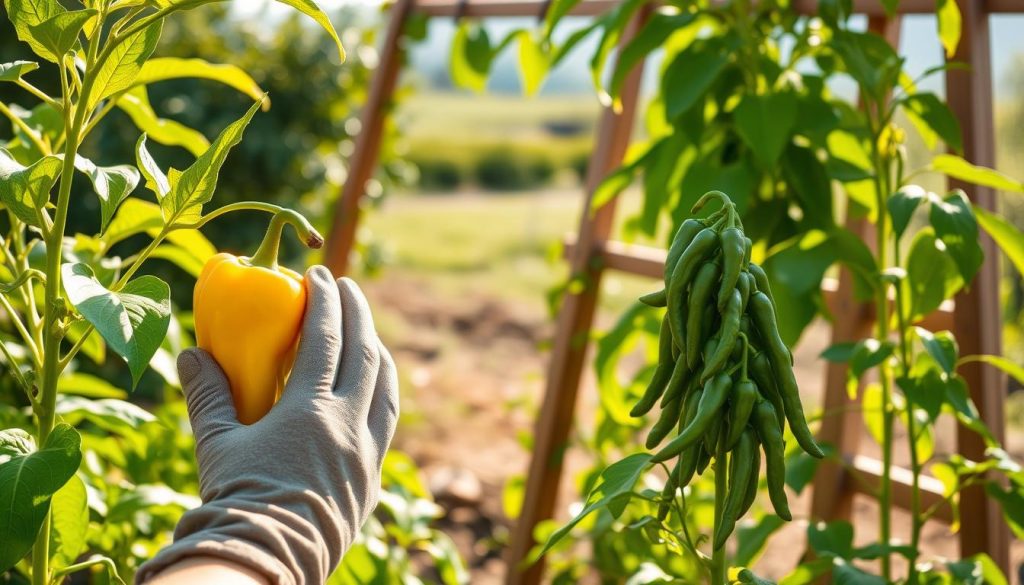
Growing pepperoncini and banana peppers is rewarding for gardeners. They need similar care, making them great for your garden. Knowing what each needs will help you get a big harvest.
Choose a sunny spot with good drainage for your pepper plants. They love warm weather and consistent temperatures between 70-85°F. Add organic compost to your soil for the best growing conditions.
- Plant peppers after the last frost date in your region
- Space plants 18-24 inches apart
- Use support stakes for taller pepper varieties
- Water consistently, keeping soil moist but not waterlogged
Fertilize your peppers every 4-6 weeks with a balanced, low-nitrogen fertilizer. Pepperoncini take 70-80 days to grow, while banana peppers are ready in 60-75 days.
Harvest peppers when they’re fully colored and sized. Pick pepperoncini when they’re light green to yellowish-green. Banana peppers are ready when they’re bright yellow or red. Use sharp pruning shears to cut peppers, leaving a small stem.
- Watch for common pests like aphids and spider mites
- Protect plants from extreme heat with light shade
- Rotate crop locations yearly to prevent soil-borne diseases
With the right care, you’ll have a big harvest of tasty peppers for your cooking.
Storage Methods and Shelf Life
Keeping your banana peppers and pepperoncini fresh is important. Knowing how to store them right can make them last longer. This way, you can enjoy their taste for a longer time. Whether they’re fresh or pickled, the right storage is crucial.
Storing fresh peppers needs special care to keep them fresh. The storage method for banana peppers and pepperoncini is different. Each type has its own needs for keeping fresh.
Fresh Pepper Storage Strategies
- Refrigerate unwashed peppers in a perforated plastic bag
- Store in the crisper drawer at 40-45°F
- Use within 1-2 weeks for optimal freshness
- Keep peppers dry to prevent mold growth
Pickled Pepper Preservation
Pickling turns pepperoncini vs banana peppers into tasty condiments that last long. This process not only makes them last longer but also makes them taste better.
| Pepper Type | Refrigerated Shelf Life | Sealed Jar Shelf Life |
|---|---|---|
| Fresh Banana Peppers | 1-2 weeks | N/A |
| Pickled Banana Peppers | 6-12 months | 1-2 years |
| Fresh Pepperoncini | 1-2 weeks | N/A |
| Pickled Pepperoncini | 6-12 months | 1-2 years |
To keep them fresh longer, always use clean jars for pickling. Vacuum-sealed containers are the best for keeping peppers fresh and preventing bacteria.
Where to Buy and What to Look For
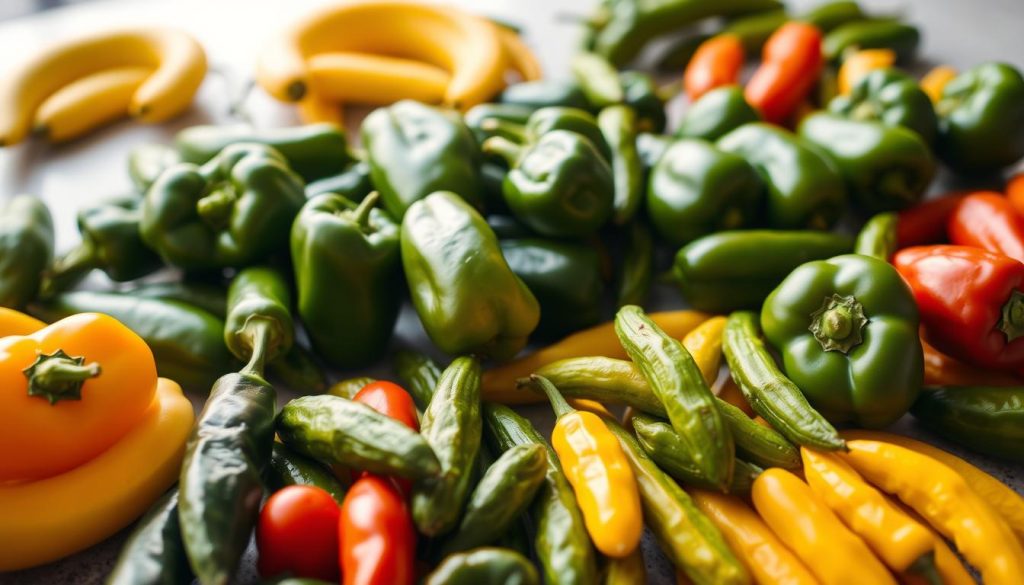
Finding top-notch banana peppers and pepperoncini can make your cooking better. These peppers are found in many places, each with its own benefits for cooks and food lovers.
When looking for banana peppers or pepperoncini, check out these great places:
- Local Farmers’ Markets: Fresh, seasonal peppers with peak flavor
- Grocery Store Produce Sections: Consistent availability year-round
- Specialty Food Stores: Wider variety of pepper types
- Online Specialty Retailers: Rare and unique pepper selections
Choosing the best peppers means paying attention to a few things. Here’s what to look for:
- Bright, vibrant color without blemishes
- Firm texture with smooth skin
- No soft spots or wrinkled appearance
- Fresh, crisp smell
For pickled peppers, check the jar seals, expiration dates, and ingredients. Artisan and small-batch brands often have better flavors than big brands.
Pro tip: Local Latino and Mediterranean stores usually have the freshest banana peppers and pepperoncini. They offer authentic, high-quality peppers.
Conclusion
Exploring banana peppers vs pepperoncini is a journey through flavor and culinary versatility. Each pepper has its own taste that can make your cooking better. Whether you like a mild tang or a subtle kick, knowing the difference helps you choose.
Using pepperoncini vs banana peppers can turn simple dishes into amazing meals. Pepperoncini add a tangy Mediterranean flavor, while banana peppers bring a sweeter taste. They’re great in sandwiches, salads, pizzas, and charcuterie boards because of their moderate heat and versatility.
When picking between banana peppers and pepperoncini, think about what your recipe needs and what you like. They’re good for you because they’re low in calories. Try swapping them in different recipes to find new flavors that will excite your taste buds.
Knowing about these peppers opens up a world of cooking possibilities. Use this knowledge to explore, taste, and enjoy the unique qualities of banana peppers and pepperoncini in your cooking.

